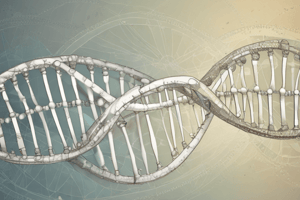Podcast
Questions and Answers
What is the primary function of the phosphate group in the nucleotide structure of DNA?
What is the primary function of the phosphate group in the nucleotide structure of DNA?
- To provide energy for DNA replication
- To form hydrogen bonds between nitrogenous bases
- To form the backbone of the DNA molecule (correct)
- To determine the sequence of amino acids in proteins
What is the term for the process by which genetic information encoded in DNA is copied into RNA?
What is the term for the process by which genetic information encoded in DNA is copied into RNA?
- Translation
- Transcription (correct)
- Mutation
- Gene regulation
What type of mutation involves the insertion or deletion of one or more nucleotides, resulting in a change in the reading frame of the genetic code?
What type of mutation involves the insertion or deletion of one or more nucleotides, resulting in a change in the reading frame of the genetic code?
- Frameshift mutation (correct)
- Chromosomal mutation
- Point mutation
- Gene duplication
What is the term for the process by which alleles for different traits are sorted independently during gamete formation?
What is the term for the process by which alleles for different traits are sorted independently during gamete formation?
What is the term for the process by which genetic information encoded in RNA is used to build a polypeptide chain?
What is the term for the process by which genetic information encoded in RNA is used to build a polypeptide chain?
What type of inheritance pattern occurs when a dominant allele is always expressed when present, and a recessive allele is only expressed when no dominant allele is present?
What type of inheritance pattern occurs when a dominant allele is always expressed when present, and a recessive allele is only expressed when no dominant allele is present?
What is the term for the random change in allele frequency that occurs in a population over time?
What is the term for the random change in allele frequency that occurs in a population over time?
What type of modification to DNA can affect gene expression without altering the underlying DNA sequence?
What type of modification to DNA can affect gene expression without altering the underlying DNA sequence?
Flashcards are hidden until you start studying
Study Notes
Genetics in Bio
DNA Structure
- Double helix model: two complementary strands of nucleotides twisted together
- Nucleotides composed of:
- Sugar molecule (deoxyribose)
- Phosphate group
- Nitrogenous base (A, C, G, or T)
- Hydrogen bonds between nitrogenous bases hold strands together
Genetic Code
- Sequence of nitrogenous bases determines genetic information
- 64 possible codons (triplets of bases) code for 20 amino acids and 3 stop signals
- Codons are read in sequence to form a polypeptide chain (protein)
Inheritance Patterns
- Mendel's Laws:
- Law of Segregation: each trait is determined by two alleles
- Law of Independent Assortment: alleles for different traits are sorted independently
- Dominant and recessive alleles:
- Dominant allele always expressed if present
- Recessive allele only expressed if no dominant allele present
- Autosomal dominant/recessive and sex-linked inheritance patterns
Gene Expression
- Transcription: DNA -> RNA (messenger RNA, transfer RNA, ribosomal RNA)
- Translation: RNA -> protein
- Gene regulation:
- Epigenetic modifications (e.g., methylation, histone modification)
- Gene regulatory elements (e.g., promoters, enhancers, silencers)
- Environmental factors (e.g., temperature, light)
Genetic Variation
- Mutations: changes in DNA sequence
- Types of mutations:
- Point mutations (single base change)
- Frameshift mutations (insertion/deletion)
- Chromosomal mutations (e.g., duplication, inversion)
- Genetic drift: random change in allele frequency
- Gene flow: exchange of genes between populations
DNA Structure
- Composed of a double helix with two strands of nucleotides.
- Nucleotides consist of deoxyribose sugar, a phosphate group, and one of four nitrogenous bases: adenine (A), cytosine (C), guanine (G), or thymine (T).
- Hydrogen bonds between nitrogenous bases stabilize the two strands, pairing A with T and C with G.
Genetic Code
- Genetic information is encoded in sequences of nitrogenous bases.
- There are 64 possible codons, which are combinations of three nucleotide bases.
- Codons represent 20 amino acids and three stop signals, pivotal in protein synthesis.
- Codons are read sequentially during translation to assemble polypeptide chains.
Inheritance Patterns
- Mendel's Laws:
- Law of Segregation: Each trait is influenced by two alleles that segregate during gamete formation.
- Law of Independent Assortment: Alleles for different traits assort independently, leading to genetic variation.
- Dominant alleles mask recessive alleles, thus only dominant traits are expressed in the presence of a dominant allele.
- Inheritance patterns include autosomal dominant, autosomal recessive, and sex-linked traits.
Gene Expression
- Transcription converts DNA to RNA, producing messenger RNA (mRNA), transfer RNA (tRNA), and ribosomal RNA (rRNA).
- Translation synthesizes proteins from the mRNA template.
- Gene expression is regulated by:
- Epigenetic modifications such as DNA methylation and histone modifications.
- Gene regulatory elements like promoters, enhancers, and silencers that influence transcription.
- Environmental factors such as temperature and light affecting gene activity.
Genetic Variation
- Mutations lead to alterations in the DNA sequence which contribute to genetic diversity.
- Types of mutations include:
- Point mutations: a single nucleotide change.
- Frameshift mutations: changes caused by insertions or deletions that shift the reading frame.
- Chromosomal mutations: major structural changes to the chromosome, like duplication or inversion.
- Genetic drift refers to random changes in allele frequencies within a population.
- Gene flow involves the exchange of genetic material between different populations.
Studying That Suits You
Use AI to generate personalized quizzes and flashcards to suit your learning preferences.




